Listen:
Check out all episodes on the My Favorite Mistake main page.
My guest for Episode #309 of the My Favorite Mistake podcast is La Tonya Roberts, the founder and CEO of Harmony Consulting Group. La Tonya is a fractional COO, HR consultant, and executive coach who helps women entrepreneurs scale their service-based businesses from six to seven figures through systems, strategic planning, and operational excellence. Before launching her firm, she built her career at top consulting organizations like Deloitte and Booz Allen, where she developed deep expertise in organizational change and operational leadership.
In this episode, La Tonya shares her favorite mistake—staying too long in roles she had outgrown, taking on too much responsibility, and ultimately burning out. After experiencing both physical and emotional fatigue, including a dramatic moment that sent her to the hospital, she realized that her tendency to overfunction in high-demand environments was unsustainable. Those hard lessons eventually led her to rediscover joy in her work by launching her own business focused on operational harmony and intentional growth.
La Tonya explains how she now helps founders—especially women—build scalable, process-driven businesses without sacrificing their well-being. She also shares how she uses tools like ChatGPT to automate repetitive tasks and increase efficiency, both in her business and her clients'. We also talk about the importance of aligning systems, people, and strategy, and how La Tonya’s clients benefit from her experience in both large enterprises and nimble startups.
Listeners will hear practical advice on avoiding burnout, building systems that run without you, and why “work-life harmony” may be a better goal than elusive “balance.”
Questions and Topics:
- What’s your favorite mistake from your career so far?
- What were the early signs of burnout you experienced—and how did others notice?
- How did you recover and bounce back from burnout the first time?
- When did you start recognizing burnout as a recurring pattern?
- Was that recognition part of your decision to leave Deloitte and start your own firm?
- How do you now prevent burnout while running your own business?
- What does “work-life harmony” mean to you, and how do you practice it?
- For those unfamiliar, what exactly does a fractional COO do?
- Do your clients tend to be in growth mode or crisis when they reach out to you?
- Who is your ideal client, and what challenges are they facing?
- How do you describe your operations methodology without using “Lean Six Sigma”?
- How do you help clients streamline processes with AI tools like ChatGPT?
- What mistakes do people make when using AI tools in their businesses?
- Can people set up fully private AI tools for their businesses?
- What’s your vision for how AI and human roles will work together in the future workforce?
- Why did you choose to focus on helping women entrepreneurs in particular?
- How long do your fractional COO engagements usually last?
- Could you ever see yourself becoming a full-time COO again under the right conditions?
- What is the Harmony Ops Collective and how does it help business owners?
- What’s included in your free operations checklist, and how can people use it?
Scroll down to find:
- Video version of the episode
- How to subscribe
- Quotes
- Full transcript
Find LaTonya on social media:
Video of the Episode:
Quotes:
Click on an image for a larger view
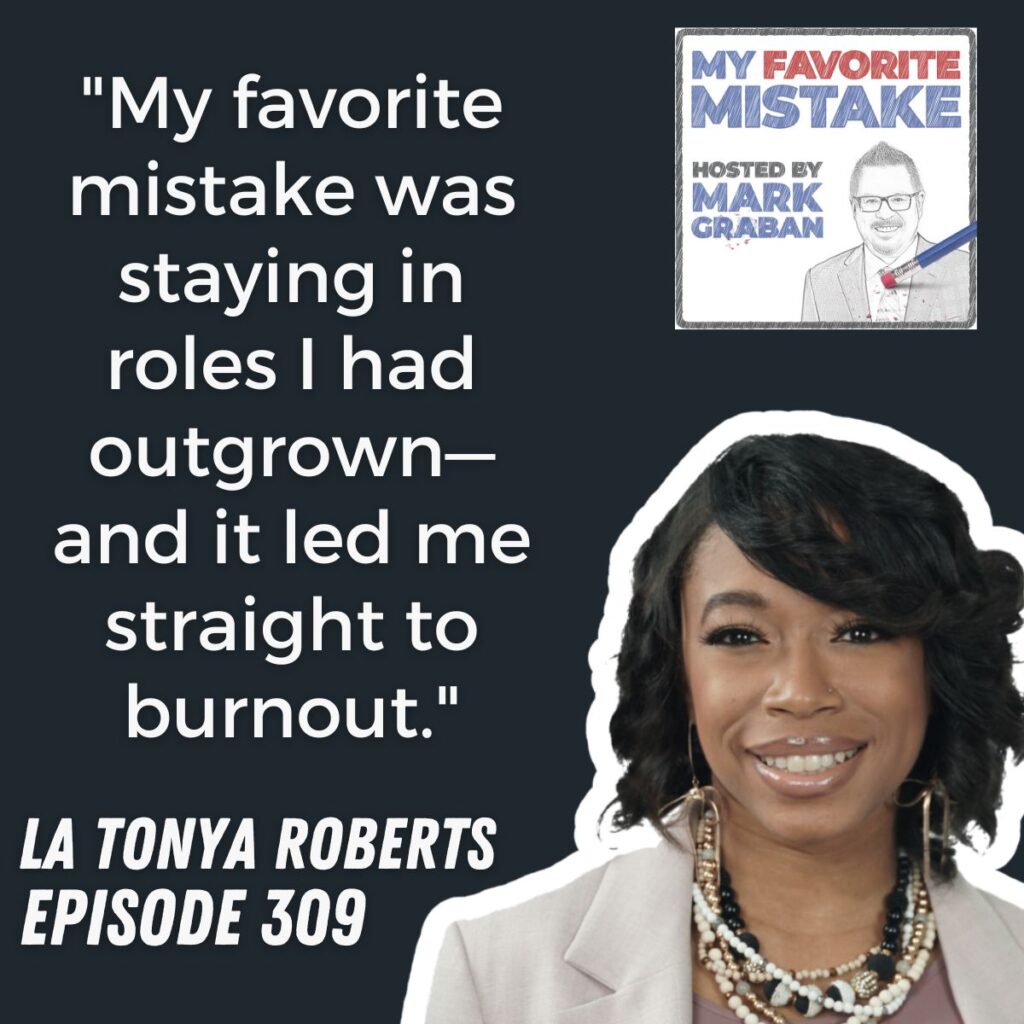
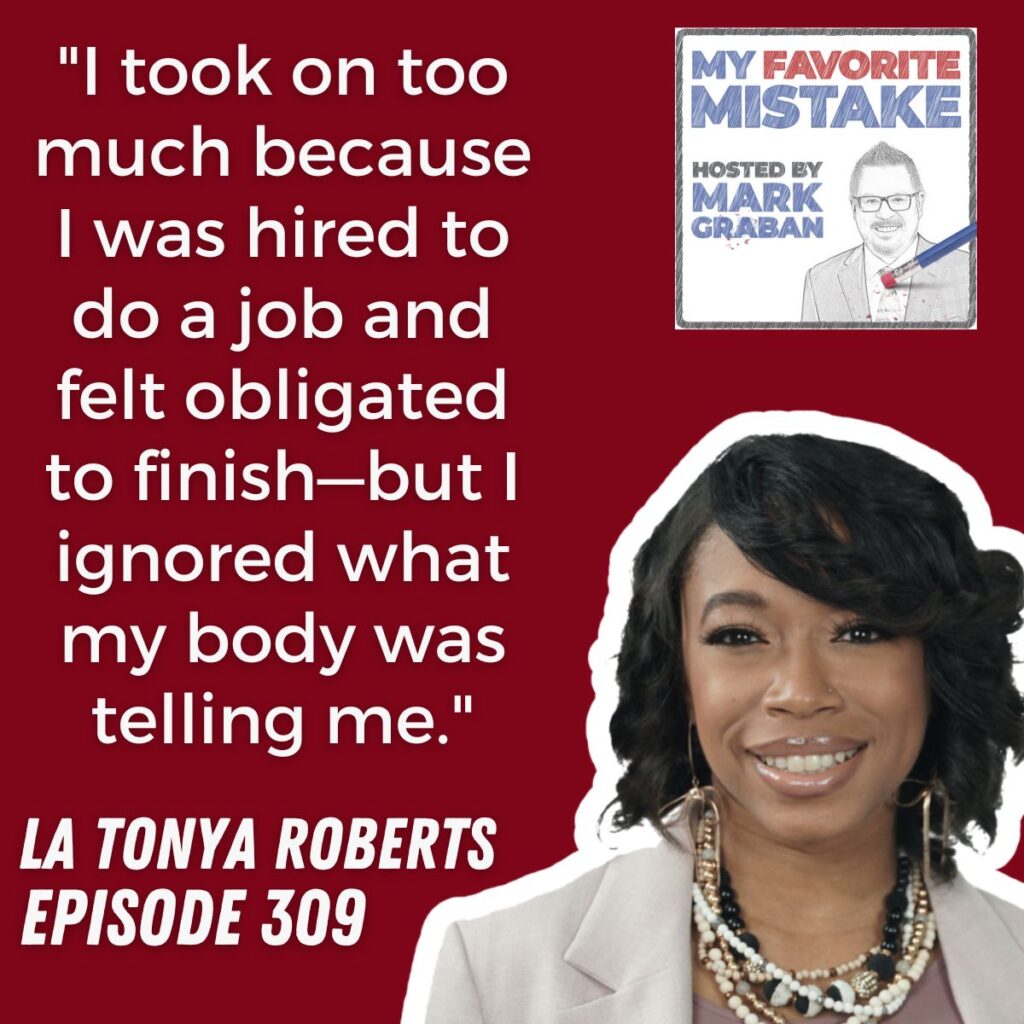
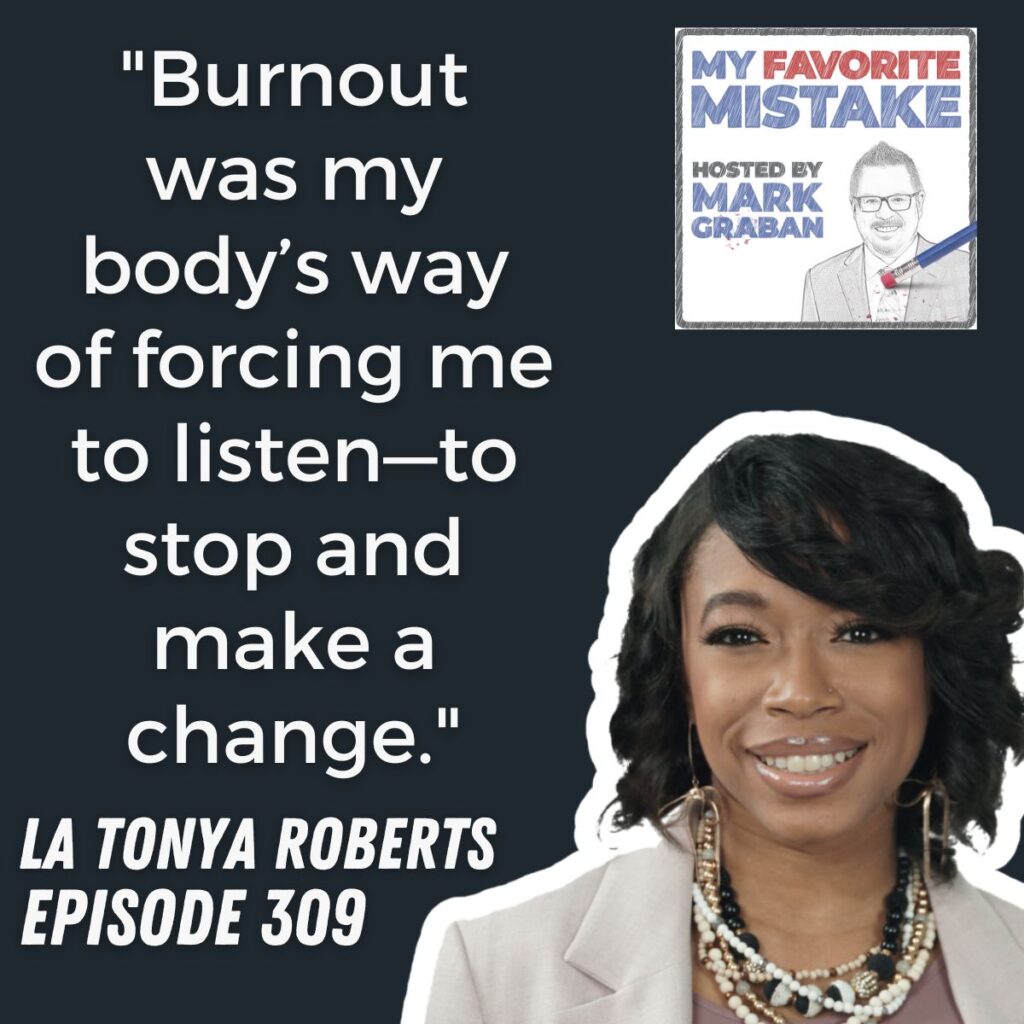
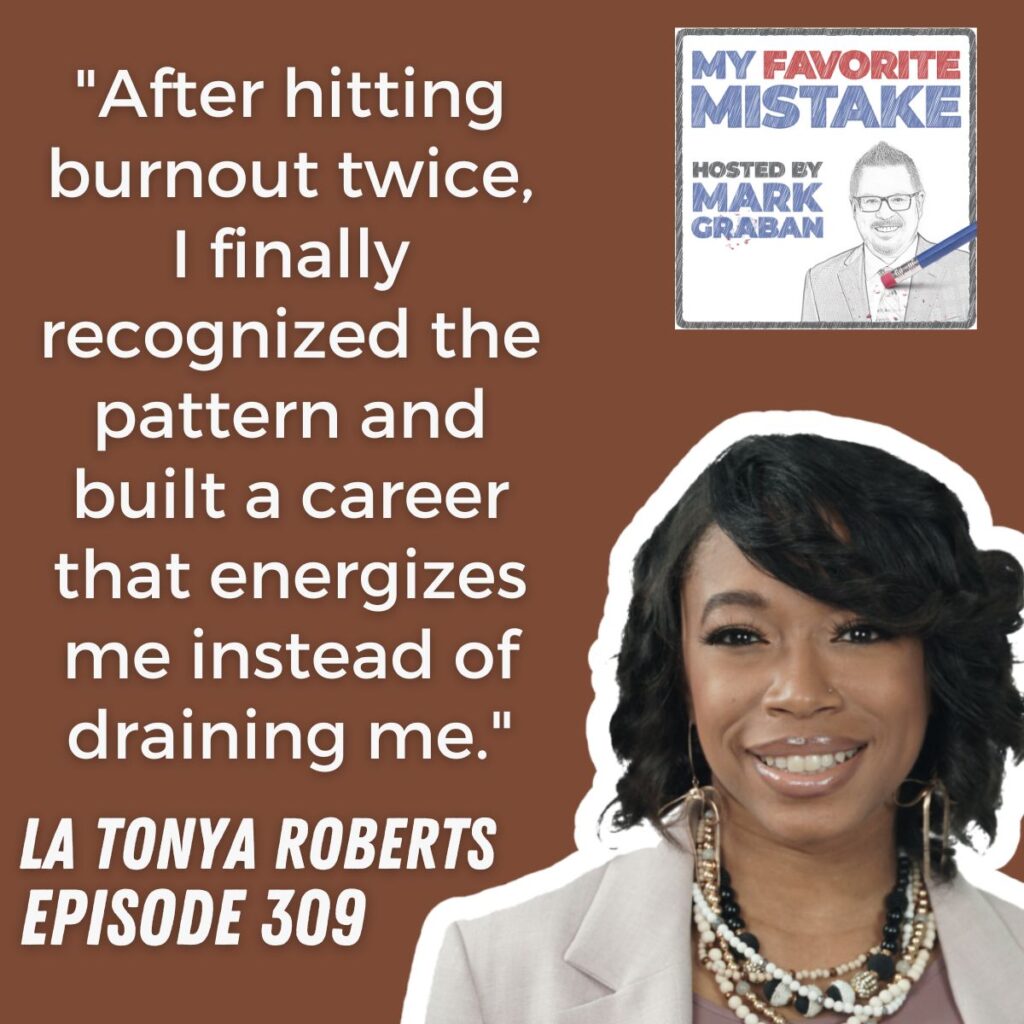
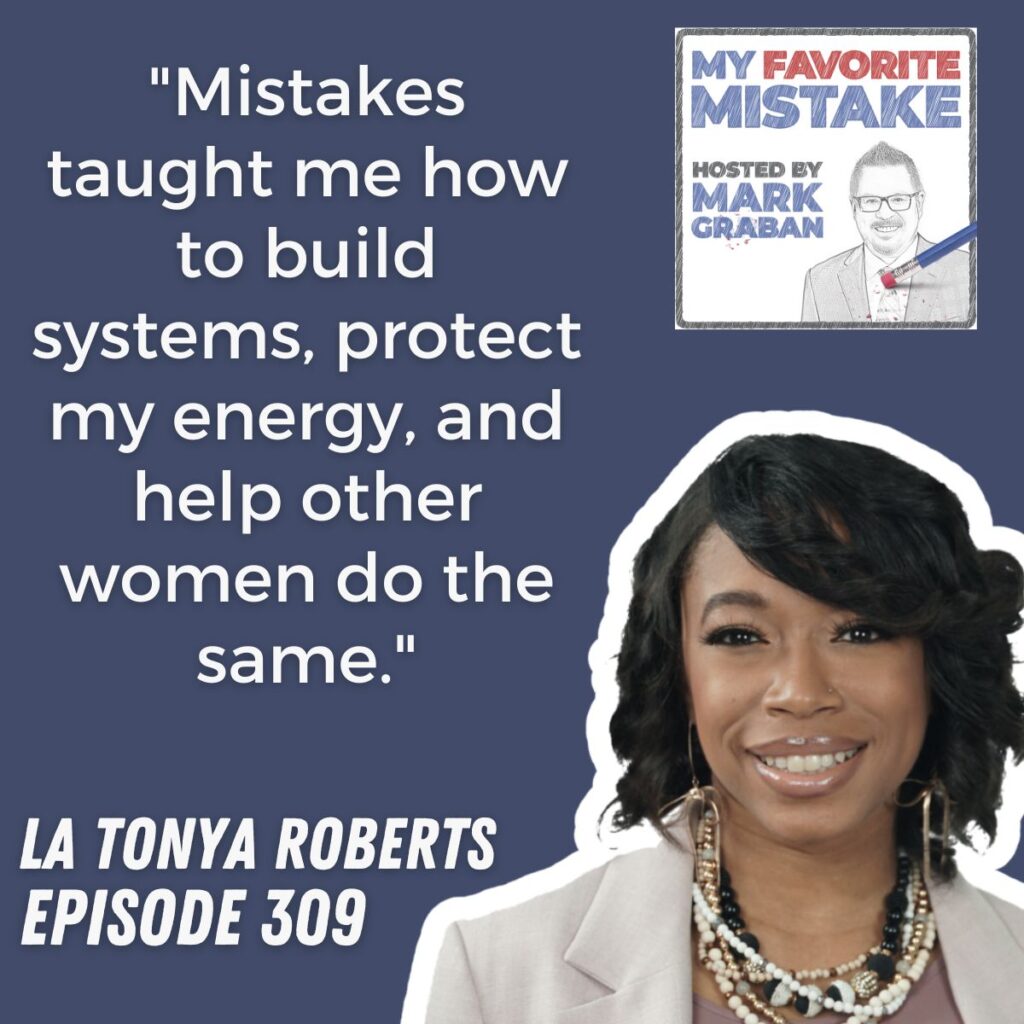
Subscribe, Follow, Support, Rate, and Review!
Please follow, rate, and review via Apple Podcasts, Podchaser, or your favorite app — that helps others find this content, and you'll be sure to get future episodes as they are released weekly. You can also financially support the show through Spotify.
You can now sign up to get new episodes via email, to make sure you don't miss an episode.
This podcast is part of the Lean Communicators network.

Other Ways to Subscribe or Follow — Apps & Email
Automated Transcript (May Contain Mistakes)
Mark Graban: Hi. Welcome to My Favorite Mistake. I'm your host, Mark Graban. We're joined today by La Tonya Roberts. She is CEO, a fractional COO—Chief Operations Officer—and HR consultant and executive coach at her firm, Harmony Consulting.
Mark Graban: La Tonya specializes in helping women entrepreneurs scale their businesses from six to seven figures through streamlined operations. She has a robust background, having honed her skills at Deloitte and other top consulting firms. La Tonya has an MS in HR Management and certifications in Four-Dimensional Change Management. So, La Tonya, thanks for joining us today.
La Tonya Roberts: I'm doing great. Happy to be here.
Mark Graban: Great. Good to have you here. And there's a lot to talk about, but I think first things first—we'll dive right in. I would love to hear, from the different things you've done in your career, what's your favorite mistake?
La Tonya Roberts: My favorite mistake—it's one that I had to learn over and over again—and that is staying in a role that I've outgrown and taking on too much. Throughout my career, I've been hired for various things, say organizational transformation or change management consulting. But then I get in a role and, being deeply curious, I want to try new things and I discover all these new skills.
La Tonya Roberts: But then I've taken on three roles, and that can lead to burnout or just not being happy in the job anymore. But I stay because I was hired to do a thing and finish what I started.
La Tonya Roberts: But what that did for me was—after a couple cases of burnout to my demise, right?—hard lesson learned, I did find out what truly made me happy. And that led to a career in operations, which really is a combination of all the things that I've done over the nearly 20 years of consulting. It allowed me to really lean in on my gifts and truly serve my clients, as well as make myself happy and enjoy the work that I do.
Mark Graban: Yeah. Well, I'm glad you found your way into something that you really enjoy and you're thriving with. And hopefully that doesn't lead to any more instances of burnout. What were some of the signs that you saw—or maybe that others saw—when it came to burnout?
La Tonya Roberts: We always talk about the Sunday scaries. It's that feeling of, “Oh, I don't want to go to work tomorrow.” You think it's normal. And then it's the exhaustion. I remember one time I went to work and I was just feeling really tired. I thought, “Oh, I've just been working hard.”
La Tonya Roberts: I hopped on a conference call. It was an hour, and by the end of the call, I was laying across my desk because I was so tired.
Mark Graban: Yeah, this is before being on camera, right?
La Tonya Roberts: Thank goodness, this was before being on camera. I mean, we had Skype back then, but I was not on camera. So yeah, my coworkers had to take me to the hospital. And then I was diagnosed with fatigue. I didn't even know that was a thing. I wasn't at work for two weeks. So that was one. Sometimes you get weight loss, mood changes, appetite changes, just physical and mental exhaustion—just not wanting to be there.
La Tonya Roberts: And I think our body tells us when something is wrong even before our mind has caught up and processed what's going on. What I learned is to really pay attention to the signs that our body gives us.
Mark Graban: Yeah, that happens to a lot of people. A lot of people on the podcast have talked about that. How did you best bounce back? Did that mean changing jobs and getting a fresh start, or finding strategies to get out of that fatigue and burnout?
La Tonya Roberts: Yeah, that was early in my consulting career—maybe three or four years in. So I did not change jobs, but I really started focusing on self-care. I used my paid time off, took my vacations, took breaks throughout the day. Eventually, I got into meditation. Later on, I actually went through a health and wellness coaching certification because I wanted to understand how my nutrition, sleep, and all the other parts of well-being tied into how I showed up. That was really helpful.
Mark Graban: And was there a point where you recognized the pattern? You said you'd gone through this multiple times, and that happens. Did you just hit a point where you recognized, “Okay, this has happened before, it's happening again”?
La Tonya Roberts: It did. I started recognizing the patterns. The second time I dealt with it, I ended up getting vertigo. My body just shuts down and says, “Girl, you've got to stop.” So I started really paying attention to what was going on.
La Tonya Roberts: When I decided to walk away from Deloitte at the time, I was starting to feel really tired. I wanted a little bit more. I was on a really stressful project during COVID—it was a COVID-related project. So you're dealing with all the transitions. I had just moved my family from D.C. to Atlanta, so we're dealing with that and kids and change—it was just a lot. I just really wanted to make sure I wasn't put in a position like I had been before, where I was burned out. But I still wanted to do the work I like…
La Tonya Roberts: So I made a plan to walk away and go all in on my business.
Mark Graban:
Yeah. And I'm sure, I mean, maybe you could explain a little bit more or elaborate on—you talked about finding what truly makes you happy. I think it's fair to say I'm not a burnout expert. I've gone through this in different phases of my career.
Mark Graban:
I think it's fair to say that hard work and long hours in and of itself doesn't always lead to burnout. There are other variables, other factors. How would you say your experience was leading to burnout? Or what's different now that you're working hard in your business?
La Tonya Roberts:
Oh, I'm very intentional about what I call work-life harmony. The name of my business is Harmony Consulting Group. Harmony is my favorite word in the world. I don't think you really have work-life balance—at some point you're going to give more in one area or the other. But I do believe in harmony.
La Tonya Roberts:
What that means for me is planning out—which is something I do with my clients—we're strategically planning. We're looking out three years from now, five years from now, one year from now, and figuring out: what are those areas throughout the year where you're going to have to lean into your business and work heavily? And then we build in periods of rest.
La Tonya Roberts:
So, for example, last week I was out for a week on vacation—my own solo sabbatical—so I could rest. I had just gone through two months of working really hard. I'm very intentional about that.
La Tonya Roberts:
I also put systems in place so that it's not just on me. Even though you're running a business, it doesn't mean you have to work every single role. So I have systems in place so when I do go on vacation, I can actually vacation and not worry about the business. It keeps going without me.
La Tonya Roberts:
And when I was in corporate, even though I was on a team, it was still harder to do that. Your team is still going, and they’re reaching out saying, “Hey, I need this.” Sometimes we put ourselves in a position of being the only one, and that’s the wrong thing to do.
La Tonya Roberts:
We should be training other people and making sure that we're not the only stopgap in the process. In my business, I make sure I’m not the only one.
Mark Graban:
Yeah. And I'm sure all of those experiences and things you've learned along the way help you coach and serve the entrepreneurs you're working with. For those who don't know what a fractional COO does—and I’m asking partly on my own behalf—can you talk through a typical engagement?
La Tonya Roberts:
Yeah. Think of us as the person who comes in to make your vision a reality. Say you want to launch a new program—you have a great idea. What I do is make sure your idea is very clear: What are you trying to create? Who is it for? What's your timeline? How do you define success?
La Tonya Roberts:
Then I put your systems and structure in place—your technology, your processes, your people. I make sure it runs like a well-oiled machine so you can stay in love with your business and not become a slave to it.
Mark Graban:
And how often is an entrepreneur reaching out because they're stalled out or struggling to grow versus facing a crisis?
La Tonya Roberts:
It's more often that they're ready to grow, but they don’t know how. I do have some that are in crisis—like “I'm going to lose my business if I don’t do something soon.” I just did a proposal like that. But mostly it's folks making $250K to $500K who know they need new clients and need to move out of that owner-operator role.
La Tonya Roberts:
They need to start hiring—contractors or employees—and transfer knowledge and capabilities. I love working with that group because they’re driven and ready to grow, but they don’t know how. I tell everyone, I’m the how. Tell me what you want, and I’ll give you ten ways to make it happen.
Mark Graban:
That’s not always the strong suit of the CEO—especially the visionary, big idea types.
La Tonya Roberts:
Exactly. I love the details. Let me come in and pull all that out.
Mark Graban:
Are you mostly working with founders and owner-CEOs?
La Tonya Roberts:
Yes. All of my clients have been founders—consultants, coaches, or service providers who left corporate. They’re used to a big machine behind them, and now it’s just them, an assistant, and a few contractors. It’s a different environment, and I understand both sides—big companies like Deloitte and Booz Allen and smaller firms—so I can adapt tools and methods accordingly.
Mark Graban:
When you and I talked before, I think we found common ground in improvement methodologies. My background is more Lean—Toyota-based. Others on the podcast have come from a Lean Six Sigma perspective. How do you present that kind of methodology to entrepreneurs?
La Tonya Roberts:
I don’t use the term “Lean Six Sigma.” Behind the scenes, we can geek out with that language. But I’ll talk to clients about their processes: What’s working? What’s not? What are your critical path activities?
La Tonya Roberts:
Then I’ll integrate workflows and AI—ways to go faster, do things better—and it blows their minds. I might say, “Give me a routine task like content planning or proposal writing.” I’ll create a custom GPT for them, and what used to take a week now takes an hour. That’s huge.
Mark Graban:
What do you use to build a custom GPT for a business?
La Tonya Roberts:
I use ChatGPT or Claude. Hopefully, they have documented processes or sample proposals. I scrub them for proprietary info, understand their products and services, and see how they deliver. I also want transcripts from sales calls—Zoom plus Otter or Fathom.
La Tonya Roberts:
I load that into the GPT, and it maps the pain point to a service. It builds out a mostly complete proposal that they just tweak a little. It saves so much time. I use it myself too.
Mark Graban:
I was going to ask—you beat me to it! So you’re applying all this to your own consulting firm?
La Tonya Roberts:
I am my own client. I test these things on myself first before rolling them out.
Mark Graban:
I think you've touched on one mistake people might make with public AI tools—putting proprietary info into the system. That's a good tip. Are there other common mistakes you see when people are new to AI tools?
La Tonya Roberts:
Yes—know where and how to train your AI. For example, include your voice and tone so it sounds like you—not like a generic AI bot. And the good news is that tools like ChatGPT are very conversational now.
La Tonya Roberts:
You don’t have to be a prompt engineer. You can just say, “Hey, Chat, I want to build a content planning program for my podcast. Here's my audience. What should I do for the next year?” And boom—it gives you a full three-month plan. It doesn’t have to be scary.
La Tonya Roberts:
Also, be sure to go into your settings and check the box that says, “Do not train the model on my data.” It’s hard to find for some reason, but it’s worth doing.
Mark Graban:
Are there ways to set up a truly private AI tool with no data-sharing risk?
La Tonya Roberts:
Not completely. Your GPTs can be public or private. Claude lets you set up projects that are private. With ChatGPT, you can create a custom GPT and make sure you don’t share it—or only share with specific links. That helps.
Mark Graban:
This is going to keep evolving rapidly. What do you see as the next wave of benefits for your business or your clients when it comes to AI?
La Tonya Roberts:
I think of the future workforce as a combination of human and AI employees. The AI shouldn’t replace people—it should complement them. Use AI for repetitive tasks and people for strategic work and client support.
La Tonya Roberts:
Some folks will always say, “I want to talk to a human.” So you still need that personal touch. But you can absolutely increase efficiency and blend AI with people so they’re working together, not against each other.
Mark Graban:
Again, our guest today is La Tonya Roberts. Her firm is Harmony Consulting. I want to ask—what inspired you to focus on helping women entrepreneurs?
La Tonya Roberts:
Women face different challenges than our male counterparts. I'm passionate about women's empowerment. I do coach men too, but I have a soft spot for supporting women and helping them succeed.
La Tonya Roberts:
My approach—my personality—tends to resonate well with women. I love the “woo”—things like human design and mindset work. My male clients are like, “What is this?” But I can also be very Type A and results-driven. It depends on the fit and chemistry. I just want to see women thrive.
Mark Graban:
As a fractional COO, how long do you typically stay engaged with a client?
La Tonya Roberts:
It depends. I strive for long-term relationships. The minimum is three months so I can deliver results. I work on a retainer or project basis. Sometimes we do an annual plan and quarterly reviews. My goal is to help them grow to where they need a full-time COO.
La Tonya Roberts:
That could take a year—or more. I’m in it for the journey.
Mark Graban:
And “fractional” doesn’t just mean short-term—it’s part-time hours each week across multiple clients?
La Tonya Roberts:
Correct. I’m still a member of your C-suite team. I can have management responsibility, budget control—just like a full-time COO, but at a fraction of the time and cost. It makes the expertise accessible.
Mark Graban:
As they grow, have you ever thought about joining a company full-time if it were the right fit?
La Tonya Roberts:
I don’t limit myself. I love consulting—it’s something new every day. But if the right company aligned with my values and it was a great fit, why not? Maybe I’d take it on for a specific timeframe.
Mark Graban:
One more thing before we wrap up—tell us about the Harmony Ops Collective. What is that?
La Tonya Roberts:
That’s my free Facebook community. It’s a space to collaborate, learn, and grow. I share tools, strategies, and tips for those in operations roles or entrepreneurs doing ops themselves.
La Tonya Roberts:
We’re starting training soon, including a three-day challenge. Later this year, we’ll launch paid cohorts that go deeper. If a company can’t afford a full engagement with me, they can send someone through the cohort and have that person lead their operations.
Mark Graban:
That’s smart—a scalable way to help more people. And you also have an operations checklist, right?
La Tonya Roberts:
Yes—it’s a free checklist covering eight key areas: growth model, customer outreach, performance metrics, lean ops, and more. With clients, we go deeper using a more detailed assessment. But the checklist is a great starting point to see where you're on track and what needs improvement.
Mark Graban:
Great. We'll put a link to that in the show notes. Again, we've been joined today by La Tonya Roberts. Her website is HarmonyConsultingGroup.org. Please check the show notes for more ways to connect. La Tonya, thank you for being here.
La Tonya Roberts:
Thank you! So happy to be here.
3 Actionable Takeaways from the Episode
1. Prioritize Self-Care and Recognize Burnout Signs:
La Tonya highlights the importance of recognizing burnout signs such as exhaustion and mood changes, which she experienced before fully transitioning to her own business. Implementing self-care strategies and being mindful of the “Sunday scaries” can help prevent burnout.
2. Strategic Planning for Work-Life Harmony:
Emphasize the need for strategic planning to achieve work-life harmony. La Tonya discusses setting up intentional periods for work and rest to avoid burnout in her business, citing recent examples of her own practices.
3. Use AI Tools to Improve Business Efficiency:
La Tonya describes how she helps clients use tools like ChatGPT to automate and streamline business processes, which can significantly save time on tasks like proposal writing. Implementing similar AI solutions can enhance operational efficiency and free up time for strategic activities.

